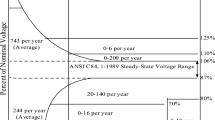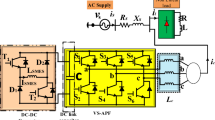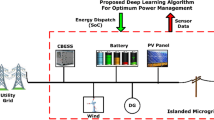Abstract
Concerning the power quality issues in the power distribution network due to load uncertainties and improper impedance matching of the inductances, deep reinforced learning (DRL)-based inductively coupled DSTATCOM (IC-DSTATCOM) is proposed. First, by analyzing the impedance matching principle, the expression of source, load and filter current is derived with the help of inductive filtering transformer. And second, an individual DRL subnet structure is accumulated for each phase using mathematical equations to perform the better dynamic response. A 10-kVA, 230-V, 50-Hz prototype direct coupled distributed static compensator (DC-DSTATCOM) and IC-DSTATCOM experimental setup is buit to verify the experimental performance under uncertainties of loading. The IC-DSTATCOM is augmented better dynamic performance in terms of harmonics curtailment, improvement in power factor, load balancing, potential regulation, etc. The benchmark IEEE-519-2017, IEC-61727 and IEC-61000-1 grid code are used to evaluate the effectiveness of the simulation and experimental study.


















Similar content being viewed by others
Data availability
The raw processed data required to reproduce the above findings cannot be shared at this time due to legal/ethical reasons.
Abbreviations
- w p a, w p b and w p c :
-
Weighting values of active component of load current
- w q a, w q b and w q c :
-
Weighting values of reactive component of load current
- u p a, u p b and u p c :
-
In phase unit voltage template
- u q a, u q b and u q c :
-
Quadrature unit voltage template
- w cp and w cq :
-
Output of DC and AC side PI controller
- w sp and w sq :
-
Total active and reactive components
- w a :
-
Mean active weight
- w r :
-
Mean reactive weight
- i r a, i r b and i r c :
-
Total reactive weight
- v s a, v s b and v s c :
-
Supply voltages
- i l a, i l b and i l c :
-
Load currents
- i s a, i s b and i s c :
-
Supply currents
- i a a, i a b and i a c :
-
Total active weight
- \(i_{{{\text{s}}a}}^{*} ,i_{{{\text{s}}b}}^{*} ,i_{{{\text{s}}c}}^{*}\) :
-
Reference supply currents
References
Kumar C, Mishra MK (2015) Operation and control of an improved performance interactive DSTATCOM. IEEE Trans Ind Electron 62(10):6024–6034
Xu C, Dai K, Chen X, Kang Y (2016) Unbalanced PCC voltage regulation with positive- and negative-sequence compensation tactics for MMC-DSTATCOM. IET Power Electron 9(15):2846–2858
Fan Y, Zhou Q, Wang J, Mu S, Wang L (2021) Application of superconducting-magnetic-energy-storage-based current-source active power filter in photovoltaics for harmonic mitigation. IEEE Trans Appl Supercond 31(8):1–4
Penthia T, Panda AK, Patnaik N, Mohanty PR (2020) Performance of SMES system with non-linear dynamic evolution control approach for pulsed power load compensation. IET Gener Transm Distrib 14:1872–1881
Panda AK, Penthia T (2017) Design and modeling of SMES based SAPF for pulsed powerload demands. Int J Electr Power Energy Syst 92:114–124
Arya SR, Patel MM, Alam SJ, Srikakolapu J, Giri AK (2019) Phase lock loop-based algorithms for DSTATCOM to mitigate load created power quality problems. Int Trans Electr Energy Syst. https://doi.org/10.1002/2050-7038.12161
Mangaraj M, Panda AK (2019) Modelling and simulation of KHLMS algorithm-based DSTATCOM. IET Power Electron 12(9):2304–2311
Mangaraj M, Panda AK, Penthia T, Dash AR (2020) An adaptive LMBP training based control technique for DSTATCOM. IET Gener Transm Distrib 14(3):516–524
Mangaraj M (2021) Operation of Hebbian least mean square controlled distributed static compensator. IET Gener Transm Distrib 15:1939–1948
Mangaraj M, Panda AK (2021) Sparse LMS algorithm for two-level DSTATCOM. IET Gener Transm Distrib 15(1):86–96
Arya SR, Maurya R, Giri AK (2018) Enhancement of power quality in wind based distributed generation system using adaptive vectorial filter. Int J Emerg Electr Power Syst 19(5):20180008
Fei J, Wang H (2020) Experimental investigation of recurrent neural network fractional-order sliding mode control of active power filter. IEEE Trans Circuits Syst II Express Briefs 67(11):2522–2526
Fei J, Chen Y (2020) Dynamic terminal sliding-mode control for single-phase active power filter using new feedback recurrent neural network. IEEE Trans Power Electron 35(9):9904–9922
Lin F, Tan K, Lai Y, Luo W (2019) Intelligent PV power system with unbalanced current compensation using CFNN-AMF. IEEE Trans Power Electron 34(9):8588–8598
Hou S, Chu Y, Fei J (2021) Robust intelligent control for a class of power-electronic converters using neuro-fuzzy learning mechanism. IEEE Trans Power Electron 36(8):9441–9452
Shukl P, Singh B (2020) Delta-bar-delta neural-network-based control approach for power quality improvement of solar-PV-interfaced distribution system. IEEE Trans Ind Inf 16(2):790–801
Peng L, Wu W, Hu K (2021) A multicell network control and design for three-phase grid-connected inverter. IEEE Trans Ind Electron 68(4):2740–2749
Fei J, Wang H, Fang Y (2022) Novel neural network fractional-order sliding-mode control with application to active power filter. IEEE Trans Syst Man Cybern Syst 52(6):3508–3518
Fei J, Liu L (2022) Real-time nonlinear model predictive control of active power filter using self-feedback recurrent fuzzy neural network estimator. IEEE Trans Ind Electron 69(8):8366–8376
Kumar N, Singh B, Panigrahi BK (2019) PNKLMF-based neural network control and learning-based HC MPPT technique for multiobjective grid integrated solar PV based distributed generating system. IEEE Trans Ind Inf 15(6):3732–3742
Kundu S, Singh M, Giri AK (2022) Implementation of variable gain controller based improved phase locked loop approach to enhance power quality in autonomous microgrid. Int J Numer Model Electron Netw Devices Filelds. https://doi.org/10.1002/jnm.3082
Sharma J, Andersen PA, Granmo OC, Goodwin M (2021) Deep Q-learning with Q-matrix transfer learning for novel fire evacuation environment. IEEE Trans Syst Man Cybernet Syst 51(12):7363–7381
Qureshi A, Giri AK, Arya SR et al (2022) Power conditioning using DSTATCOM in a single-phase SEIG-based isolated system. Electr Eng 104:111–127
Jin JX, Tang YJ, Xiao XY, Du BX, Wang QL, Wang JH, Wang SH, Bi YF, Zhu JG (2016) HTS power devices and systems: Principles, characteristics, performance, and efficiency. IEEE Trans Appl Supercond 26(7):66
Kundu S, Singh M, Giri AK (2022) Control algorithm for coordinated operation of wind-solar microgrid standalone generation system. Energy Sources A Recov Util Environ Eff 44(4):10024–10044
Kundu S, Singh M, Giri AK (2024) Synchronization and control of WECS-SPV-BSS-based distributed generation system using ICCF-PLL control approach. Electr Power Syst Res 226:109919
Chen XY et al (2021) An SMES-based current-fed transformerless series voltage restorer for DC load. IEEE Trans Power Electron 36(9):9698–9703
Kundu S, Singh M, Giri AK (2024) SPV-wind-BES-based islanded electrical supply system for remote applications with power quality enhancement. Electr Eng 106:279–294
Kundu S, Singh M, Giri AK (2024) Adaptive control approach-based isolated microgrid system with alleviating power quality problems. Electr Power Components Syst 52(7):1219–1234
Funding
This study was not funded by any external agency.
Author information
Authors and Affiliations
Contributions
Dr. Mrutyunjaya Mangaraj has conducted the experimental analysis Prof. S M Muyeen has reviewed the paper and supervised the research as required Prof. B Chitti Babu has analyzed the MATLAB simulation study for the different scenarios Dr. N Toushif Khan has written the overall manuscript based upon simulation and experimental study Dr. S Singh has contributed for overall correction and formatting as per journal guidelines Dr. A Chakravarty cross-checked the grammatical error and plagiarism.
Corresponding author
Ethics declarations
Conflict of interest
Authors have no conflicts of interest to disclose that are relevant to the content of this work.
Additional information
Publisher's Note
Springer Nature remains neutral with regard to jurisdictional claims in published maps and institutional affiliations.
Rights and permissions
Springer Nature or its licensor (e.g. a society or other partner) holds exclusive rights to this article under a publishing agreement with the author(s) or other rightsholder(s); author self-archiving of the accepted manuscript version of this article is solely governed by the terms of such publishing agreement and applicable law.
About this article
Cite this article
Mangaraj, M., Muyeen, S.M., Babu, B.C. et al. Deep reinforced learning-based inductively coupled DSTATCOM under load uncertainties. Electr Eng (2024). https://doi.org/10.1007/s00202-024-02446-0
Received:
Accepted:
Published:
DOI: https://doi.org/10.1007/s00202-024-02446-0




